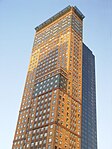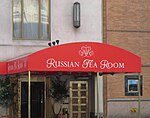CitySpire
CitySpire (also known as CitySpire Center) is a mixed-use skyscraper at 150 West 56th Street in the Midtown Manhattan neighborhood of New York City. Completed in 1990 and designed by Murphy/Jahn Architects, the building measures 814 feet (248 m) tall with 75 stories. CitySpire was developed by Ian Bruce Eichner on a site adjacent to the New York City Center theater. When completed, CitySpire was the second-tallest concrete tower in the United States after the Sears Tower. The skyscraper has an octagonal plan with a dome inspired by that of the New York City Center. The facade is made of stone with glass windows, and it contains setbacks at the 46th and 62nd floors. The building has entrances at 56th and 55th Streets, connected by a passageway that forms part of 6½ Avenue. The lowest 22 floors of the tower are for commercial use. Above are luxury apartments, which are larger on higher floors. Eichner proposed CitySpire in 1984, acquiring unused air rights above City Center and making improvements to the theater to almost double the tower's area. After several agencies approved the project, City Center began construction in 1985 and was topped out by June 1987. A controversy ensued when the building exceeded its approved height by 11 or 14 feet (3.4 or 4.3 m); Eichner agreed to add dance-studio space to compensate for the height overrun, but he ultimately never built the space. Soon after CitySpire's opening in 1989, the building went into foreclosure, and there were complaints of a whistling noise from the roof for two years.
Excerpt from the Wikipedia article CitySpire (License: CC BY-SA 3.0, Authors).CitySpire
West 56th Street, New York Manhattan
Geographical coordinates (GPS) Address External links Nearby Places Show on map
Geographical coordinates (GPS)
| Latitude | Longitude |
|---|---|
| N 40.764166666667 ° | E -73.979722222222 ° |
Address
CitySpire Center
West 56th Street 150-156
10019 New York, Manhattan
New York, United States
Open on Google Maps








